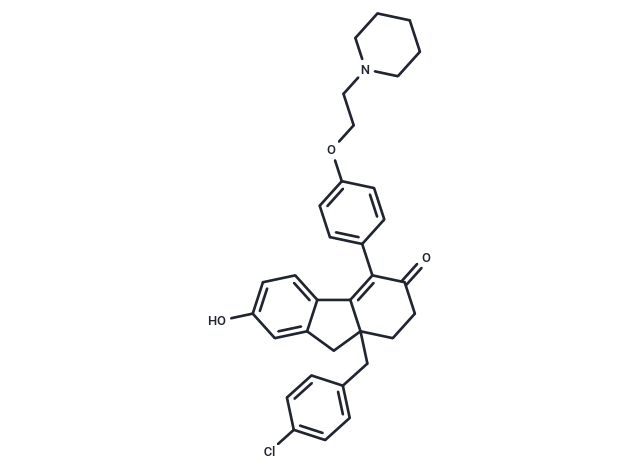Shopping Cart
- Remove All
 Your shopping cart is currently empty
Your shopping cart is currently empty

CMP8 is a selective ligand for estrogen receptor. CMP8 binds to the mutant estrogen receptor ligand binding domain (ERLBD). CMP8 has IC50 values of 29 nM , 41 nM, 1100 nM and 2200 nM for MGERα, MGRERα, hERα and hERβ, respectively.

| Pack Size | Price | Availability | Quantity |
|---|---|---|---|
| 1 mg | $152 | In Stock | |
| 5 mg | $312 | In Stock | |
| 10 mg | $446 | In Stock | |
| 25 mg | $690 | In Stock | |
| 50 mg | $930 | In Stock | |
| 100 mg | $1,180 | In Stock | |
| 200 mg | $1,580 | In Stock | |
| 1 mL x 10 mM (in DMSO) | $391 | In Stock |
| Description | CMP8 is a selective ligand for estrogen receptor. CMP8 binds to the mutant estrogen receptor ligand binding domain (ERLBD). CMP8 has IC50 values of 29 nM , 41 nM, 1100 nM and 2200 nM for MGERα, MGRERα, hERα and hERβ, respectively. |
| Targets&IC50 | MGRERα:41 nM, MGERα:29 nM, ERα (human):1100 nM, ERβ (human):2200 nM |
| In vivo | CMP8 is dosed in male Balb-c mice (4 mg/kg, ip). In mammalian cells, the plasma concentration after 4 h is 1.5-fold its EC50. It has a Cmax of 0.5 μM after 30 min.[1][2] |
| Molecular Weight | 528.08 |
| Formula | C33H34ClNO3 |
| Cas No. | 851107-28-3 |
| Smiles | C(C12C(C=3C(C1)=CC(O)=CC3)=C(C(=O)CC2)C4=CC=C(OCCN5CCCCC5)C=C4)C6=CC=C(Cl)C=C6 |
| Relative Density. | 1.30 g/cm3 (Predicted) |
| Storage | Powder: -20°C for 3 years | In solvent: -80°C for 1 year | Shipping with blue ice. | ||||||||||||||||||||||||||||||
| Solubility Information | DMSO: 50 mg/mL (94.68 mM), Sonication is recommended. | ||||||||||||||||||||||||||||||
Solution Preparation Table | |||||||||||||||||||||||||||||||
DMSO
| |||||||||||||||||||||||||||||||

Copyright © 2015-2025 TargetMol Chemicals Inc. All Rights Reserved.